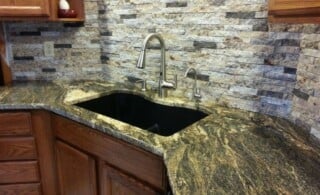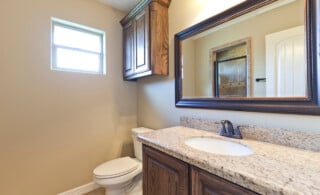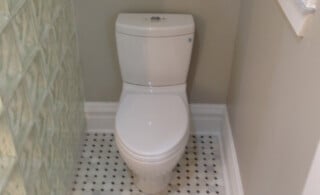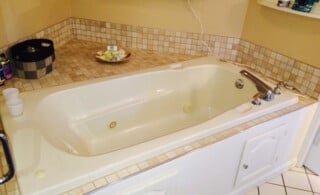On This Page:
Modern sinks offer a multitude of designs aimed at every budget and lifestyle. Whether you’re adding a touch of glamor to a dated bathroom or offering hands-free clean up after a dirty project, there’s a sink to meet every need.
Like anything else in your home that experiences regular use, your sink requires occasional maintenance. Fortunately, most sink related upkeep is easily accomplished with a quick DIY investment. But, occasionally an issue will arise that may require the expertise of a professional. To help you know when it’s time for some elbow grease and when it’s time to call a pro, here’s a quick how-to on bathroom sink repair.
Repair Or Replace?
Properly cared for, certain bathroom sinks can last for decades. While there may come a time when additional repairs seem pointless, a quick improvement is (almost) always worth it. If you’re wondering if your sink falls into the “almost” repairable category, here are a few situations that will require a replacement:
- Cracked Basin
Regardless of how the crack happened, a damaged basin won’t do anything to improve the appeal of your kitchen or bathroom. Light cracking can be remedied with a resurfacing of the porcelain, but major cracks will impact your sink’s ability to hold water. Small leaks can be temporarily dammed with epoxy, but your sink should be replaced as soon as possibleSome sinks also experience cracking near the drain. If your sink has cabinets, avoid extreme overcrowding. Too many items crammed below your sink will apply pressure to your pipes and drain. A thin pipe may give way before a cast-iron basin will, but even thicker plastic or fiberglass basins will crack from heavy pressure.
- Improper Cleaning
Natural stone sinks are prone to damage from incorrect cleaning. The use of acidic or abrasive cleaners can cause permanent damage to most stone basins. Hard water can also leave unsightly mineral deposits. If you live in an area with mineral-rich water, make sure to dry your sink after each use.Though your cleaning options vary depending on your sink’s make and model, it’s important to ensure your cleaning products are compatible with your sink’s material (before using them).
- Permanent Stains
Occasionally (in the case of buying a new home), permanently stained sinks can be inherited. While stains won’t impact your sink’s functionality, blemishes will affect the overall appeal of your home. Depending on how attached you are to a particular sink, a replacement may be necessary.
- Updated Decor
After a remodel, your old sink may clash with your updated décor. If you’ve gone for a contemporary look and your sink is a plastic drop-in, it’s time for an update.
If you have an older sink that’s brimming with character (but shows a little age), don’t be hasty to find a replacement. In many cases, the craftsmanship invested in older designs is impossible to find in contemporary sinks. So, here are a few tips to help inject a little life back into your old sink.
- Chipped Stone – Chipped stone is easier to fix than cracked stone. Broken pieces can be reattached by washing the broken surface with acetone and using epoxy to reattach the fragments. Some stone surfaces have filler putty available for small pieces that are missing.
- Chipped Porcelain – Chipped porcelain can be fixed with a porcelain repair compound. Once you’ve mixed the compound to your desired color, use a razor blade to apply the mixture. After drying, smooth the edges with a pad of cotton soaked in nail polish remover.
- Rusty Faucets – Rusty or sticky faucets can easily be remedied with a quick replacement. Many styles are available, ranging from as little as $11.75 for a basic model to as much as $1,600 for a high-end design.
- Aesthetics – If your countertops look rough, your sink probably will too. New tile on the countertop surrounding your sink will make a remarkable difference. A new backsplash will also give your countertops an additional shot of style. Tile types vary widely so be sure your design fits your budget.
- Doesn’t Hold Water – If the water drains out of your basin even after you’ve engaged the stopper, a simple cleaning may be all that’s needed.
Repairing A Sink Stopper
How the Stopper Works
When you lift the plunger at the back of your faucet (called a stopper rod) a small system of levers pulls the stopper down and secures it in place. A rubber o-ring completes the seal, holding water in your basin.
Cleaning and Repair
- Clear everything from under your sink to give yourself ample working room.
- Your drainpipe will have a retaining nut attached to a horizontal pivot rod. Loosen the retaining nut and remove the horizontal pivot rod.
- The opposite end of the horizontal pivot rod connects to a vertical bar with holes called the clevis. Indicate where the rod connects to the clevis with a permanent marker.
- Mark where the clevis screw connects to the stopper rod. Loosen the screw to remove the clevis and soak the clevis and horizontal pivot rod in a mild cleaning solution or vinegar.
- Lift the stopper out of the basin and inspect the O-ring beneath the stopper head. If the O-ring is brittle or cracked, replace it. Rinse and the stopper with a mild cleaning solution.
- Reattach the clevis to the stopper rod, tightening the clevis screw just enough to hold it in place. Reattach the horizontal pivot rod to the clevis according to your previous mark. When you pull the stopper, make sure the entire system moves.
- Tighten the retaining nut at the drainpipe, ensuring the horizontal pivot rod still moves freely. (Too tight and the rod won’t move.)
- Loosen the clevis screw and pull up on the stopper rod, pulling the stopper down onto the drain.
- Slide the clevis screw as far up the stopper rod as you can and tighten.
- Fill your basin and check for leaks. If you notice water draining, adjust the clevis screw and retaining nut respectively until you achieve a satisfactory seal.
Drain Repair
Drain repair may seem simple, but if done incorrectly, you could face costly repairs in the future. If you decide to tackle this project on your own, here a few tips to ensure your sink repair is a success:
- If It Doesn’t Fit, Don’t Force It – Especially when working with plastic (PVC) piping, forcing a fit with incorrect sizing will cause joints to weaken and crack. Breaks in piping will very quickly become leaks (which will require further repairs in addition to your original task).
- If It’s Stuck, Don’t Force It – Prying on pipes is a bad idea. Plumbing is interconnected, meaning that unnecessary prying will damage your entire system (even behind your wall). It’s better to work gently, bracing the other pipes if possible. Soft tapping with a hammer will loosen a stuck piece if combined with a thread lubricant.
- Plumber’s Tape Is Not A Sealant – Plumber’s tape is a strip of metal used for supporting pipes. Thread seal tape (also known as plumber’s tape as well) refers to a strip of thin, PTFE tape used to help threads join securely. Thread seal tape combats leaks but is no substitute for plumber’s putty.
- More Tape Isn’t More Sealing – Thread seal tape should only be wrapped around threads three times. Any more than three will compromise the seal.
- Read the Label – If you use a commercial drain cleaner, read the label. Certain products are not safe for all systems.
- Corrosion Happens – With metal pipes, expect corrosion. If you have corrosion, be careful when unclogging severe blockage. If you’re using a drain snake, the snake can easily break through the trap. A broken trap will dump the clog onto the surface below your sink and require replacing the trap.
- Don’t Be Squeamish – Hair and soap scum are the most common clogs. There’s no easy way to eliminate these clogs (be prepared to use your hands). Wear gloves.
Other DIY Sink Repairs
Some DIY tasks may sound complex but are actually quite simple:
- Unclogging a drain – A sink snake (or auger) can cost as little as $5.00 but is a very efficient method of unclogging hair and grime. A drain-clearing chemical can be purchased for around the same price, but double check the label to ensure compatibility with your plumbing. Regimented drain cleaning is highly recommended. Once a week pour a tablespoon of baking soda and ¼ cup of lemon juice or vinegar down your drain. Let the mixture sit for 30 minutes and rinse with hot water.
- Fixing a drip – You faucet’s handles are called taps. Your taps have a valve that allows water to flow or stop depending on its position (on or off). The stopping mechanism in your taps has rubber O-rings called seats. If you have hard water, these seats are usually the first to go. With age, your seats turn from soft rubber to hard plastic and no longer successfully block water. While some homeowners replace their O-rings for $5.00, others simply replace the entire valve unit for $10.00 to $15.00. Regardless of which solution you choose, make sure to know your faucet and tap model number before making a purchase.
- Pipe replacement – Plastic can crack and metal can corrode. If either of these situations happens under your sink, you still may not have to call a plumber. A pipe wrench, some sealer and a replacement(s) are all you need, as long as your leak is under the sink. The large, curved pipe under your sink is usually the culprit and should be checked first. This curved piece is called the P-trap and is where most clogs occur. Your P-trap is also the most likely to be damaged while storing items under your sink. Repairing leaking plumbing is as easy as removing the cracked pipe and properly sealing the replacement.
When to Call A Plumber
Sometimes a repair is a bit much for the average homeowner. If you run into any of these problems the help of a professional will be necessary:
- Slow or erratic water pressure – This situation could be the result of a problem with your home’s water line or an issue with the city water supply. Main water lines are a fairly large job and best left to the professionals.
- Slow drain even after unclogging your sink – It’s possible that a larger, nastier clog exists further down your lines. Serious clogs can result from the usual build-up to tree roots growing through your outside lines.
- Leaks inside the walls – Problems involving piping systems that are not readily accessible should be left to a plumber. Because hidden pipes tend to run along any surface available, water leaks are notoriously tricky to trace. An experienced plumber will be better able to follow your leak to its source without having to break open your wall.
- Sewage backing up into your sink – Serious blockage in your sewage lines will cause a major back-up into your sinks, toilets, tubs and showers. Sewage backup is incredibly unsanitary and poses a serious health hazard.
In Conclusion
Bathroom sink repair doesn’t have to cost a fortune. With a little patience and a few simple tools, your bathroom sink can span the lifetime of your house (and maybe even longer).

 Corner Bathroom and Kitchen Sinks
Corner Bathroom and Kitchen Sinks  How Incinerating Toilets Work
How Incinerating Toilets Work  Dual Flush Toilets
Dual Flush Toilets  What to do with an Old Bathtub
What to do with an Old Bathtub  The Bidet Toilet
The Bidet Toilet 

I live in a two bathroom home and for some reason both sinks are leaking. I’m not sure why, but nothing I’ve done to fix them as worked and its beginning to damage the walls. I wasn’t sure if I should call a plumber or not, but after seeing that this is a symptom that is probably more fit for a plumber, I have decided to find one and have them come out and fix the problem.
Im helping my mom in my deceased grandparents old house. All my moms appliances are breaking firm one by one . Sink 2 toilets, air conditioner bathtub leaking out on floor, carpet desperately in need of repair for my moms very old room- the list continues. .
The sink fell on my when I was opening the p pipe to check the clog source .the entire sink . I was told it’s super expensive to fix. My moms AC started to freeze because she left it on on accidentally . They charged her $800 after just repatching the cover around the frozen pipe tube . I need help . She hasn’t the money she’s a school teacher and has no emergency money for a time like this . I feel she needs help. And honest help . Please help me as I help her … The sink and toilet don’t work it’s an ongoing issue we can’t fix because of money … The AC company says it will cost my mom $6,000-$8,000 to fix her AC . It’s now seeming fine but we live in the coachella valley and we can NOT take any chances with our AC unit . It reaches 120• easy in summer. this website sounds like an honest company who really wants to provide the best cheapest prices and advice
Thank you in advance any comment is appreciated
I really appreciated that section focused on when to call a plumber. My bathroom sink drain has been having issues lately. I’ve been wondering at what point do I need to call a professional, so it was helpful to it’s possible that problem could be worse than I think.
I need to replace the faucets in a bathroom sink. What special and professional tool do I need?
The bathroom sink at mywin laws house had both hot and cold faucets turned off for a long time because the pipes underneath leaked. I replaced the pipe that leaked but when I turned the faucets back on, water would not run from either of them. Just an initial spurt when I turned the cold back on. Why would this be?